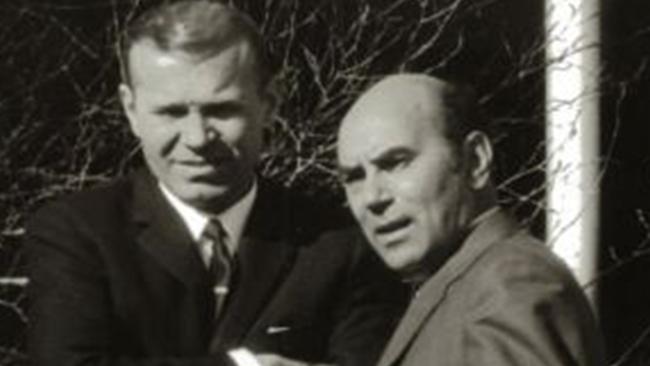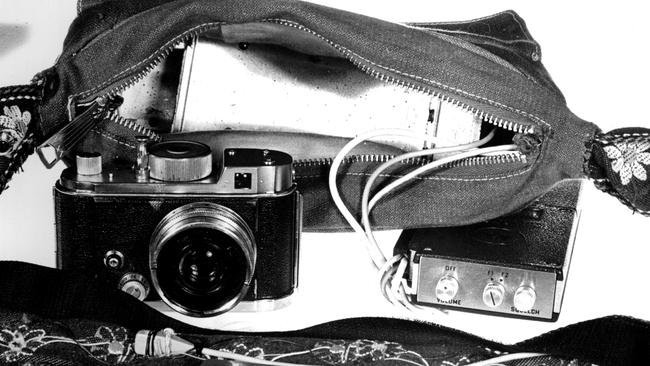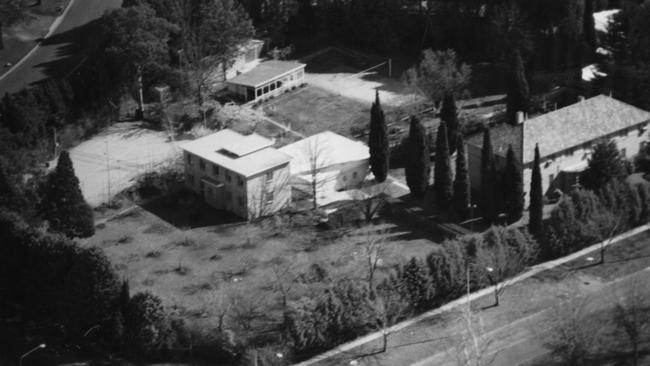ASIO admits: KGB walked among us
ASIO has finally admitted it was penetrated by a Soviet mole.

ASIO was already suspicious about Soviet moles in its ranks when the spy agency was hit by a thunderbolt in the winter of 1980.
An overseas intelligence agency told the Australian Security Intelligence Organisation that Geronty Pavlovich Lazovik, a KGB officer based at the Soviet embassy in Canberra from 1971 to 1977 “was awarded a medal for an intelligence recruitment while he was stationed in Australia”.
Moscow would not have awarded the prestigious Order of the Red Star to Lazovik unless he had cultivated a senior mole either inside ASIO or in another sensitive government agency.
ASIO rushed to examine its files on Lazovik but was horrified by what it found. “The 19 volumes previously kept by the Canberra office had been destroyed in February 1980 without a reason being recorded,” says the new volume of ASIO’s official history, released today. “While, not conclusive, this in itself was a possible indication of unauthorised and untoward action by somebody.”
The loss of files in the Lazovik case are one of numerous disclosures about ASIO’s tortured hunt for a mole within its ranks at the height of the Cold War. It is a story which mostly reflects poorly on the domestic spy agency, which bungled its hunt for suspected moles due to a mixture of incompetence, passivity and a cultural reluctance to delve into such dark corners.
But the third and final volume of ASIO’s official history, The Secret Cold War, which covers the period from 1975 to the fall of the Berlin Wall in 1989, does finally confirm the worst kept secret of the Cold War — that ASIO was penetrated by at least one Soviet mole for up to two decades during the 1970s and 80s.
It is a penetration that undermined national security for a generation and the full extent of the betrayal and the damage is still unclear.
The significance of this book, released today, is that for the first time, ASIO has allowed the authors, academics John Blaxland and Rhys Crawley, to have full access to ASIO files that deal with suspected Soviet moles inside the agency.
While the media has speculated for decades that ASIO was penetrated by one or more Soviet moles, ASIO itself never conceded this. This was despite the fact that ASIO’s Western counterparts overseas including the US’s CIA and FBI and Britain’s M15 and M16 long ago admitted that their own agencies were penetrated.

By allowing the authors, who were commissioned to write the history but who are independent of ASIO, to concede the fact of Soviet penetration in ASIO’s official history amounts to a formal, belated and historic acceptance by ASIO that it was compromised during the Cold War.
But while the book confirms the fact that ASIO was penetrated, it does not disclose the names of the suspected moles or their fate, except to hint strongly that they were encouraged to retire and were never prosecuted.
Says Blaxland: “The difficulty with it is that by 1989 all the facts were not known, so when the volume ends in 1989, the mole factor was not fully understood, so we had to access material that came to light after 1989 to make sense of it. And some of that material remains highly classified and considered by security experts highly sensitive for operational and legal reasons. That is what made it so hard to write.”
But the book, the third and final volume of ASIO’s official history, does tell for the first time from ASIO’s perspective how the agency tried to deal with the prospect that it may have a traitor in its ranks.
By the mid-1970s, when the volume begins, an unequal battle was forming between the Soviets and ASIO. Moscow began to see Australia as the potentially weak link in the Western intelligence alliance and believed that if it could break into ASIO, it would get a backdoor access into the far more important secrets of the US and Britain.
Therefore, it poured a disproportionate number of suspected KGB and GRU (Soviet military intelligence) officers into Canberra such that by the mid-1970s, there were 60 Soviet diplomats here. Up to half were assessed to be intelligence officers.
“This growth placed an unbearably heavy strain on ASIO, especially in its surveillance efforts,’’ the book says.
The notion that ASIO may have been penetrated by the Soviets first appeared during the 1954 Petrov affair but by the mid-1970s as the Soviet presence grew in Canberra, so did the fears that they had cultivated a mole inside the spy agency.
ASIO royal commissioner justice Robert Hope was alert to the danger, concluding in 1977 that there were sufficient “indicators” to cause concern and that the question of penetration “needs answering”.
At that time, ASIO had devoted only the barest of resources to looking for moles it is ranks. What’s more, there was a cultural reluctance to do so.
This was despite the fact a growing number of operations conducted by ASIO against the Soviets were failing for unexplained reasons.
“The attitude (inside ASIO) was that if the public or government believed that ASIO had been penetrated, there would be a loss of confidence in the organisation,” the book says.
“Moreover, there would be damage to ASIO’s credibility with its international partners if it lost their trust. For these, and many other complicated reasons, any discussion of penetration within the organisation was likely to be circumscribed.”
Blaxland and Crawley say the absence of a serious internal gaze or effort to uncover any existing moles was a failure on ASIO’s part.
“The organisation responsible for Australia’s internal security was not taking its own security seriously enough,” they write.
This complacency changed with the shock of the Lazovik disclosure in 1980 and the sickening realisation that the KGB resident in Canberra had almost certainly recruited an Australian agent, if not a mole inside ASIO, during his seven-year posting.
Despite the mysterious destruction of the Lazovik files, ASIO pored over the history of unsuccessful operations during his posting and examined if any ASIO staff could have been complicit in them.
In mid-1972 — only a year after Lazovik arrived — ASIO recommended that he be expelled for attempted espionage activities. But the head of ASIO, Peter Barbour, chose not to submit the recommendation to the government for fear that it would trigger another Petrov-style controversy ahead of the 1972 federal election. As a result, Lazovik stayed a further five years and did untold damage.
When ASIO completed its internal report on Lazovik in 1981, the agency found to its dismay that it only partially knew what Lazovik had been up to on barely half of his 2180 days in Australia.
But the inquiry could not identify Lazovik’s mole either inside ASIO or in other agencies.
For the next seven years, the mole investigation gathered dust until in 1988 ASIO received new information from KGB defector Colonel Oleg Gordievsky that the next two KGB residents in Canberra after Lazovik — Gennady Nayanov and Lev Koshlyakov — had also had successful tours of Australia. In other words, they had continued Lazovik’s good work. The news was chilling.
“The picture that forms from this is of consecutive KGB officers, spanning a 13-year period, who recruited and ran agents successfully despite ASIO’s efforts,” write Blaxland and Crawley.
Ironically, it was not until after the fall of the Berlin Wall that the extent and certainty of Soviet penetration of ASIO became more apparent.
KGB defectors such as Oleg Kalugin and Vasili Mitrokhin provided compelling evidence that in fact there was a mole within ASIO during the 70s and 80s. Kalugin, a former KGB general, wrote that the KGB had “excellent sources in Australia”, including “productive moles in Australian intelligence who passed us documents from the CIA and British intelligence, as well as providing us with information on subjects as varied as the peace movement and the Australian military”.
Kalugin said that through Lazovik’s mole in ASIO, the KGB was “aware of practically all steps taken or planned by ASIO against Soviet targets in Australia”.
In response to these disclosures, and other tip-offs, ASIO set up a covert team under deputy director-general Gerard Walsh to carry out a top secret investigation and the Australian Federal Police was also bought in to carry out a parallel investigation called Operation Liver.
Prime minister Paul Keating commissioned former diplomat Michael Cook to write a report into the likely penetration of ASIO and who the suspected moles might be.

ASIO’s investigations centred on a Russian translator with ASIO, George Sadil, who was found with classified documents at his house and who was arrested in 1993 on suspicion of espionage. But a successful prosecution of Sadil required direct evidence of Sadil passing the information to a foreign intelligence agency. ASIO did not have this and the espionage charges against him were eventually dropped.
The mole remains unidentified. Blaxland and Crawley suggests that there could have been more than one mole within ASIO and they are critical of the agency’s inability over many years to detect this betrayal. “ASIO’s inability to identify the degree and extent of penetration is an indictment,” they write. “Thousands of hours of covert surveillance aimed at exposing Soviet espionage operations had been for nought because of the penetration of the organisation.”
They suggest that while ASIO may have identified the suspected moles, the difficulty of mounting a successful prosecution means they got away with their treachery.
“The inconclusive investigations may have allowed possible moles to retire without being prosecuted,” they write.
It appears from the careful wording in the book that Blaxland and Crawley know more than they are permitted to write about who the suspected moles are and their fate.
The authors decline to comment on this aspect, but intelligence sources say there was vigorous debate within ASIO about even allowing the official history to concede that the organisation was compromised during the Cold War.
The notion of going even further than this and providing details of the suspected moles was vetoed on legal and operational grounds despite the information being more than 25 years old.
In the book, Blaxland and Crawley gently chide ASIO about this ongoing secrecy. “The question remains over the whole issue of penetration and whether the veil of secrecy needs to be maintained,” they write.
“While the secret of success in the espionage business is keeping one’s successes and failures secret, secrecy for secrecy’s sake can on occasions prove counter-productive.”
The 1994 Cook report, which details the penetration of ASIO and discusses the likely moles, was never released, despite numerous requests from media and academics.
Over the past three years, all three volumes of ASIO’s official history have been released, but the organisation won’t allow a further volume to examine events since 1989 because of the security and legal risks of discussing more contemporary events.
As such, we are unlikely to see the release of further details on Soviet penetration of ASIO during the Cold War for many years.
The truth about the number of moles, who they were and the damage they did to Australia will remain firmly locked inside a vault in Canberra.
Until ASIO and the government muster the courage to reveal in full what they know about this, the history of Australian espionage during the Cold War will remain incomplete.



